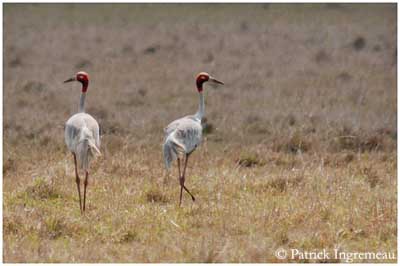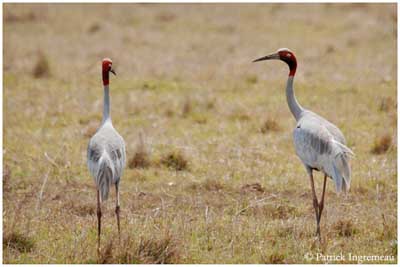
Sarus Crane
Antigone antigone
Gruiforme Order – Gruidae Family
BIOMETRICS:
Length : 155 cm
Wingspan : 250-280 cm
Weight : 6800-8400 g
LONGEVITY : Up to 26 years
DESCRIPTION:
Sarus Crane is the tallest crane species and of all flying birds, with a height of about 176 cm.
Adult male has pale grey plumage overall.
On the head, crown is covered with pale buffy-grey bare skin, while other parts of the head, upper neck and throat show orange-red bare skin. We can also see small pale grey ear patch on each side of the head. Chin and some parts of upper neck are covered with sparse black feathers.
Long, pointed bill is pale greyish. Eyes are pale brown to orange. Legs and feet are pinkish-red.
Both sexes are similar, with male larger than female.
PROTECTION / THREATS / STATUS:
Sarus Cranes are threatened by habitat loss throughout their range, with drainage of wetlands and degradation of habitats for agriculture expansion and human developments.
Use of pesticides and collisions with wires also are important threats.
Eggs can de stolen, and chicks are captured and raised for food.
However, in several parts of the range, habitat is now protected, especially breeding grounds and winter areas. Reintroduction plans are in project in portions of the historical range.
Numbers are in decline at this time, and Sarus Crane is classified as Vulnerable Species.
Fr: Grue antigone
All : Saruskranich
Esp : Grulla Sarus
Ital : Gru Antigone
Nd : Saruskraanvogel
Russe : Антигона
Photographs by Patrick Ingremeau
His website : TAMANDUA
Text by Nicole Bouglouan
Sources:
HANDBOOK OF THE BIRDS OF THE WORLD Volume 3 by Josep del Hoyo-Andrew Elliott-Jordi Sargatal - Lynx Edicions - ISBN : 8487334202
BirdLife International (BirdLife International)
Wikipedia (Wikipedia, The Free Encyclopedia)
International Crane Foundation

Juvenile is browner than adults, tinged with cinnamon. Head is covered with cinnamon-brown feathers, with very indistinct greyish ear patch.
Chick is yellowish with cinnamon-brown patches on wings and back. Short, pointed bill is pale orange-yellow, tipped whitish. Eyes are dark brown.
We can find some subspecies, showing small differences in colours, but they are very similar.
G.a. antigone, from N India and Nepal. This one has broad white collar at mid-neck and white flight feathers which cover the tail.
G.a. sharpie, from Cambodia and S Laos;
G.a. gilli, from NE Australia. In Australia, Sarus Crane is often mistaken for the very similar Brolga.
VOICE: SOUNDS BY XENO-CANTO
Sarus Crane utters loud, high-pitched calls. During courtship displays, female utters two calls while male gives only one.

HABITAT:
Sarus Crane lives mainly in various wetlands such as canals, ponds, marshes, even near humans. They can be found in cultivated areas too, and also in high-altitude wetlands.
They breed more inland, but always in wet areas.
During dry season, Sarus Crane is found in shallow wetlands, rice fields or wet grasslands.
RANGE:
Sarus Crane is resident in N Pakistan and India, Nepal, South-east Asia, and Queensland in Australia.
BEHAVIOUR:
Sarus Crane feeds on wide range of wetland plants materials, seeds and grains, and also large insects, molluscs, amphibians, reptiles and small vertebrates. When searching for food, Sarus Crane walks slowly, head down. It does not dig, but it probes the soil with its long bill.
Sarus Crane is resident in Australia and India, with only some seasonal dispersion in dry period. We can observe some limited migrations in South-east Asia.
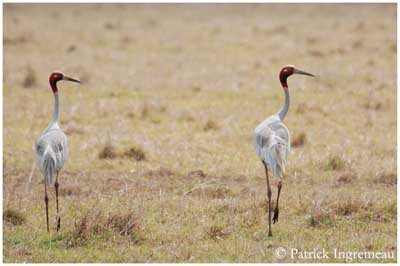
Mated pairs perform spectacular displays accompanied by unison calls.
Displays show the birds in standing posture, with head thrown back and bill upwards. Male raises the wings over its back during the unison call, while female keep them closed.
They engage dancing displays, including various different behaviours such as bowing, jumping, running in circles, tossing some plant items and wing-flapping.
These dances often occur during courtship, but they also take part in response to aggression, for relieving tensions, and they strengthen pair bonds.
Sarus Cranes, as other cranes’ species, are usually seen in family groups of up 3 to 5 birds, feeding together.
FLIGHT:
Sarus Crane flies with straight neck, and long legs trailing behind them. They perform powerful wing beats, and they are good fliers.
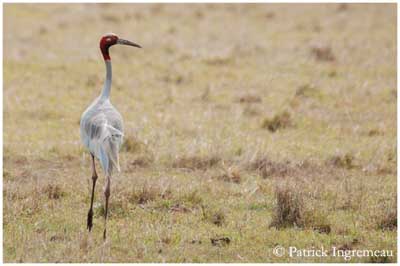
REPRODUCTION:
Sarus Crane breeds during wet season in its range.
They nest on the ground. Bulky nest is made with wetland vegetation. Nest materials are associated with breeding habitat.
Female usually lays 2 eggs, occasionally three. Incubation lasts about 31 to 34 days, mainly by female, while male defends the nest-site.
Chicks leave the nest very soon and remain with parents until they fledge about 85 to 100 days after hatching, when they are able to perform their first flight.
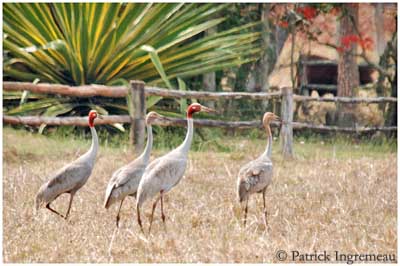
DIET:
Sarus Crane is omnivorous, feeding on wide range of food items such as aquatic plants including sedge tubers, rice, seeds and other grains, snails, crustaceans, grasshoppers and other large insects, amphibians, reptiles, fish and small vertebrates.
Sarus Crane forages in both wetlands and uplands.
